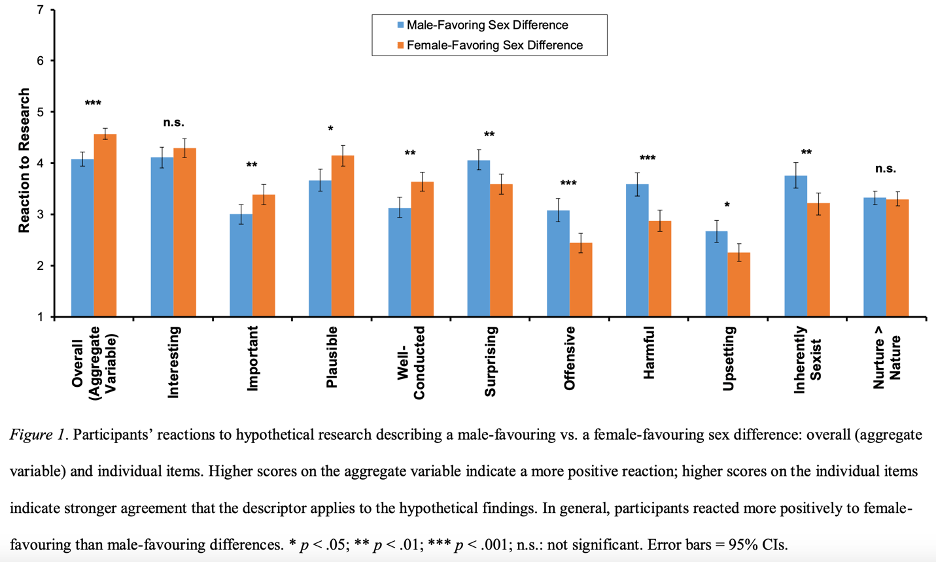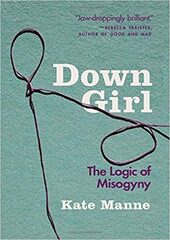The world, of course, is a messy place and disparities between men and women may have many causes. This is why carefully controlled social science is useful for examining the extent, direction, and nature of sex-related biases. Although the details can get complicated, the basic idea behind most bias studies is pretty straightforward. Researchers present participants with identical information that has some bearing on the abilities of males or females while manipulating which sex the information is about. For example, they might ask two groups of people to evaluate identical essays, telling one group that it was written by a man and the other group that it was written by a woman. If participants who believed the essay was written by a man evaluated it as more compelling, more intelligent, more insightful, and so on than participants who believed it was written by a woman, psychologists would consider that a bias in favor of men. Similarly, if one asked two groups of people to evaluate identical scientific studies that discovered that either men or women performed better on a measure of leadership, and participants who read that men outperformed women regarded the study as higher quality than participants who read that women outperformed men, psychologists would consider this a male-favoring bias (everyday people consider such patterns to be biases as well).
Contrary to expectations from the pervasive misogyny theory, across a variety of topics, samples, and research teams, recent findings in psychology suggest that such biases often favor women. For example, a paper just published in the British Journal of Psychology led by Steve Stewart-Williams found that people respond to research on sex differences in ways that favor females. In two studies, participants were asked to read a popular science article that was experimentally manipulated to suggest that either men or women have a more desirable quality (for example, men/women are better at drawing or men/women lie less often). Participants evaluated the female-favoring research more favorably than the male-favoring research. Specifically, participants found the female-favoring research more important, more plausible, and more well-conducted and found the male-favoring research more offensive, more harmful, more upsetting, and more inherently sexist. This pro-female bias was observed among both male and female participants, and in study two, the researchers replicated the results in a south-east Asian sample.
In some of our own work, we found a similar pattern for the socially desired trait of intelligence. In two studies, participants read about a (fictitious) scientific study that identified a gene associated with higher intelligence that purported to explain why either (1) men score higher on intelligence tests than women, (2) women score higher on intelligence tests than men, or (3) men and women score roughly equally on intelligence tests. Participants evaluated the scientific study to be similarly credible when it drew the conclusion that men and women score equally on intelligence tests and when women were said to score higher than men, but participants found the study less credible when it suggested that men score higher on intelligence tests than women.
In a related study, participants read about a college entrance exam that is remarkably accurate at predicting academic performance in college. They were told that either men tend to outperform women or that women tend to outperform men on the exam. Participants endorsed use of the exam more when women were said to outperform men than when men were said to outperform women. These findings suggest that people more readily accept the notion that women could be smarter than men than vice versa.
Scholars observed a similar pattern among psychology academics. In 2017, the social scientists William von Hippel and David Buss emailed a survey to a sample of psychologists, asking their beliefs about a variety of evolutionary claims and findings. These psychologists were more likely to endorse a female-favoring sex difference than a male-favoring one. Specifically, they were more likely to accept that women could have evolved to be more verbally talented than men than that men could have evolved to be more mathematically talented than women. Although these sex differences are not perfectly symmetrical (one regards verbal ability and the other mathematical ability), there is little reason to believe that an evolutionary explanation for one sex difference is more plausible than the other. Like non-academics, scientists themselves may have preferences for pro-female information over pro-male information.
We have also found that people have a stronger desire to censor science that disfavors women. In this study, participants were asked to read a series of passages from books and to decide whether the text should be censored (for example, whether it should be removed from the library, whether a professor should not be allowed to require it for class). One passage argued that either men or women make better leaders. The results showed that people wanted to censor the book more when it argued that men make better leaders than women than when it argued the opposite.
Ironically, these pro-female preferences may explain why mainstream narratives focus so assiduously on the possibility of anti-female biases: society cares more about the wellbeing of women than men and is thus less tolerant of disparities that disfavor them. A series of studies led by Katharina Block found that people care more about female underrepresentation in careers than male underrepresentation. In one such study, for example, participants were told that a particular career was dominated either by men or women. Participants were then asked whether policies and programs should be put in place to encourage whichever group was underrepresented to enter that career and whether efforts should be made to actively recruit the underrepresented group. Participants were more likely to support this social action when women were underrepresented than when men were.
Moreover, when the career was said to be accompanied by a high salary, people were more likely to say that prohibitive norms were blocking women from entering the male-dominated career than that prohibitive norms were blocking men from entering the female-dominated fields. So, people are more likely to believe that external barriers explain women's underrepresentation in desirable careers than men's underrepresentation. These findings suggest that when real world disparities exist between men and women, people are more likely to care and more likely to try to engage in corrective behavior when women are at a disadvantage.
One explanation for these pro-female biases is that humans may have evolved a general protectiveness of women. Indeed, numerous reports over the past few decades have shown that people have more sympathy for female than male suffering. For just a few examples, people are less willing to harm a female than a male, women receive more help than men, those who harm women are punished more severely than those who harm men, and women are punished less severely than men for the same crimes.
Such findings contradict the concept of "himpathy," introduced in philosopher Kate Manne's successful book Down Girl: The Logic of Misogyny. Anecdotes can create an illusion of excessive sympathy for men, but more systematic analyses suggest the opposite: People are vastly more sympathetic toward women. The success of Manne's book might indeed be a manifestation of these very sympathies, because people are more alarmed and disturbed by the possibility of a bias against women than against men.
Concerns about women's wellbeing are so strong that researchers often frame pro-female preferences and biases as harmful to women. For example, in a series of studies led by Lily Jampol, researchers asked participants to evaluate essays and give feedback to the author. Participants who then discovered the essay writer was female were more likely to adjust their performance evaluations upward than participants who were told the essay writer was male. This paper was entitled "The Dark Side of White Lies in the Workplace: Feedback to Women Is Upwardly Distorted," highlighting the potentially harmful consequences of providing softened or distorted feedback to women.
Of course, it is possible that overly positive feedback harms women in the long-run, but it might also help them, for example, if it boosts their confidence, or if evaluators internalize the flattering feedback. Furthermore, it's difficult to imagine that similar but opposite results would be framed as potentially deleterious to men. It seems as if research is often framed as "if biases favor men, then that's bad for women; if biases favor women, then that's also bad for women." For example, the women-are-wonderful effect, which is the tendency for people to view women more favorably than men, is often regarded as a form of benevolent sexism against women. We eagerly await a paper that claims preferences for men as teachers or leaders illustrates a kind of benevolent sexism against men.
Though not exhaustive, the table below summarizes findings from numerous studies demonstrating biases and attitudes that appear to favor women.
| Various findings demonstrating biases, attitudes, and treatments that favor women over men | |
| Finding | Citation |
| People prefer to spare the lives of females over the lives of males | Awad, Bonnefon, Shariff, & Rahwan, 2019 |
| People support more social action to correct female underrepresentation in careers than male underrepresentation | Block, Croft, De Souza, & Schmader, 2019 |
| Both male and female faculty preferred hiring a female over a male applicant for tenure-track assistant professorships in STEM | Ceci & Williams, 2015 |
| Offenders who victimize females receive longer sentences than those who victimize males; males who victimize females receive the longest sentences | Curry, Lee, & Rodriguez, 2004 |
| Police respond more negatively toward hypothetical male rape victims than hypothetical female rape victims | Davies, Smith, & Rogers, 2009 |
| Women receive more help than men | Eagly & Crowley, 1986 |
| Women are evaluated more favorably than men | Eagly, Mladinic, & Otto, 1991 |
| People are less willing to harm females than males | FeldmanHall, Dalgleish, Evans, Navrady, Tedeschi, & Mobbs, 2016 |
| In vehicular homicides, drivers who kill women are given longer sentences than those who kill men | Glaeser & Sacerdote, 2003 |
| People are particularly intolerant of aggression from a male and aggression directed toward a female | Harris & Knight-Bohnhoff, 1996 |
| People adjust essay performance evaluations upward when they learn the writer is female | Jampol & Zayas, 2017 |
| Women are punished less than men for the same crime | Mazzella & Feingold, 1994 |
| Controlling for numerous characteristics, men receive longer prison sentences than women | Mustard, 2001 |
| People have more empathy for female than male perpetrators and female than male victims | Osman, 2011 |
| Women are more easily seen as victims and men as perpetrators | Reynolds, Howard, Sjåstad, Zhu, Okimoto, Baumeister, Aquino, & Kim, 2020 |
| People attribute less guilt to a female-on-male sexual aggressor than a male-on-female sexual aggressor | Russel, Oswald, & Kraus, 2011 |
| People have less sympathy for male than female perpetrators and more sympathy for female than male victims | Savage, Scarduzio, Lockwood Harris, Carlyle, & Sheff, 2017 |
| Female sex offenders are given shorter sentences than male sex offenders | Shields & Cochran, 2019 |
| Women's aggression is perceived as more acceptable than men's aggression | Stewart-Williams, 2002 |
| People evaluate science on female-favoring sex differences more favorably than science on male-favoring sex differences | Stewart-Williams, Chang, Wong, Blackburn, & Thomas, 2020 |
| Psychologists agree more that it is possible that women evolved to be more verbally talented than men than that men evolved to be more mathematically talented than women | von Hippel & Buss, 2017 |
| People evaluate science that suggests that women score higher on IQ tests than men more favorably than science that suggests the opposite | Winegard, Clark, Hasty, & Baumeister, 2018 |
| People wish to censor a book that suggests that men evolved to be better leaders than women more than a book that suggests the opposite | Winegard, Clark, Bunnel, & Farkas, 2019 |
As noted above, an important feature of many of these studies (though not all of them) is that they are experimental — they randomly assign participants to evaluate information with some bearing on outcomes for men or women (or a man or woman). Many scholars who argue that sexism against women is still a major problem in modern Western societies point to real-world disparities between men and women (but ignore many others). For example, they point out that women are underrepresented in high-paying STEM careers and leadership positions, and full-time working women earn less than full-time working men. However, the existence of such differences tells us little about the causes of them, for just as correlation does not equal causation, so too disparity does not equal discrimination. And, in fact, the claim that women are underrepresented in STEM because qualified male job candidates are preferred over equally qualified female job candidates no longer seems plausible. Experimental work suggests that faculty in STEM fields have demonstrated a preference for female applicants over equally qualified male applicants. Other explanations, such as differences in personality and vocational interests therefore appear much more promising.
This does not mean, of course, that there are no biases against women. For a long time, women in the West were treated as property and were considered emotional, irrational, and incapable of contributing significantly to higher culture. It is not unimaginable that some of these prejudices still persist and shape society. For just one example, there seems to be a sort of genius bias against women, such that people more readily associate men with extremely high levels of intelligence than women. And although there is reason to believe that men might be more highly represented at the highest (and lowest) ends of intelligence, this stereotype could explain part of the underrepresentation of women at the highest ends of achievement. However, overall, the results presented here make the claim that the West is pervaded by misogyny difficult to maintain.
The mainstream view is that we live in a sexist patriarchy that is persistently unfair toward women and privileges men in nearly all ways. And any claims to the contrary are treated as the protestations of benighted conservatives or other masculinist cranks. A Google Scholar search for misogyny yielded 114,000 results, whereas a search for misandry yielded only 2,340. We suspect this difference in interest in misogyny over misandry reflects not the relative prevalence of each type of prejudice, but rather greater concern for the wellbeing of women than men. All of the arguments, anecdotes, and data forwarded to support the narrative that we live in an implacably misogynistic society, in fact, may be evidence of precisely the opposite.
Cory Clark is a social scientist. You can follow her on Twitter @ImHardcory.
Bo Winegard is an independent scholar. You can follow him on Twitter @EPoe187.






Reader Comments
Nevertheless, many women remain cautious of men’s stature and repressed propensity for violence. Most women (I suspect) at some time in their lives will have been on the receiving end of men who are condescending and sneering towards the female. Intuitively, most women probably recognise that men will always believe themselves to be vastly superior in leadership, personality, strength and stature, among other things.
Some men clearly detest women (as a group) so much that you can literally feel their revulsion because it is so palpable, so visceral it blazes a trail on the ether. This realisation can be disturbing and alarming for sensitive types.